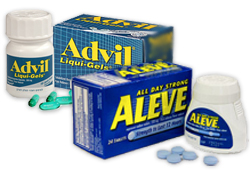1. What is Whiplash?
Whiplash is a non-medical term describing a range of head and neck injuries resulting from an acceleration-deceleration mechanism of energy transfer to the neck. Whiplash presents as a complaint of neck pain, stiffness or tenderness and decreased range of motion. This condition is most often associated with car accidents and specifically rear end collisions, although any forceful blow to the head or body can cause whiplash [1].
Over a million whiplash injuries are reported each year due to motor vehicle accidents, making this condition one of the most common non-fatal motor vehicle accident injuries [2]. Victims of both slow and high speed collisions are at risk [3]. An impact from any direction can cause a whiplash injury; however, a hit from behind is the most common. The more sudden and forceful the impact is, the more damage to the soft tissues of the body. As the head is abruptly thrown backwards and then forwards the cervical spine is forced into a position of hyperextension and then hyperflexion resulting in range of movement outside the normal limits and a subsequent whiplash injury.
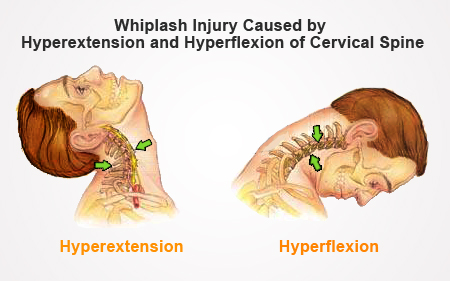
Whiplash differs in severity from patient to patient, and as such, symptoms vary between cases. Directly after impact, patients may not be aware of any neck swelling or bruising. Symptoms typically arise between 12 and 24 hours after the accident. However, pain and stiffness from whiplash is typically worse on the day following the accident and may continue to worsen with each day [4]. Many patients report that their level of discomfort is highest first thing in the morning and at night [5].

Fortunately, most people recover from the pain and stiffness associate with whiplash in a matter of weeks, but some cases require longer healing time and treatment from a physician and physiotherapist. In rare cases, patients can experience chronic pain for months or even years following their accident. Healing time varies with the level of tissue damage and the promptness of treatment.
2. Causes of Whiplash
Whiplash is caused by an abrupt and forceful hyper extension and/or hyper flexion of the cervical spine. For example, in a rear-end type motor vehicle accident the head snaps back and then forward as the soft tissues of the neck are stretched past their natural limits and are sometimes torn. Studies have shown that when a car is rear ended, the lower bones in the neck are forced backwards while the upper bones in the neck are forced forwards.
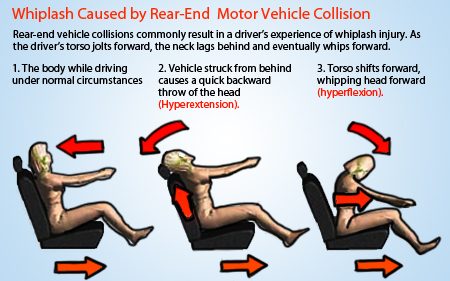
The shape of the cervical spine (neck) then becomes an abnormal S-shape [6] rather than being curved to a C-shape which is the natural resting position [7].
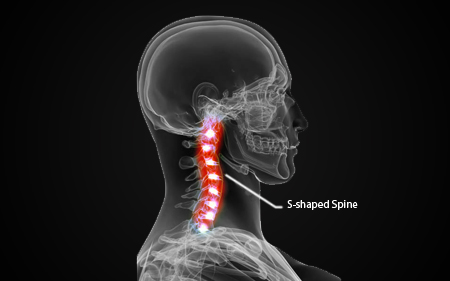
When a whiplash injury is sustained, the vertebrae of the neck move well beyond their normal range of motion, putting the soft tissues and discs of the area at risk for tearing and damage.
Common Causes of Whiplash
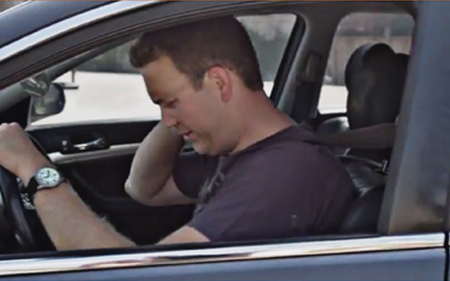
While car collisions are the most common cause of whiplash, there are a number of other activities and accidents with a strong enough impact to cause whiplash:
- Automobile accidents
- Contact sports (hockey, rugby, boxing, karate, football)
- Roller-coasters and amusement park rides
- Child abuse (shaking a child/baby; hitting a child/baby)
- A horse-back riding or cycling accident
- Any fall which causes the head to jolt backwards suddenly
- Direct impact of large or heavy object on head
3. Symptoms of Whiplash
If you have whiplash, you may experience some of the following symptoms:
- Neck and back pain and aching
- Neck stiffness and decreased range of motion
- Shoulder pain and stiffness
- Headaches (most commonly at the base of the skull radiating towards the forehead)
- Jaw pain
- Arm pain and weakness
- Fatigue
- Sensory disturbances, such as pins and needles
Some patients also experience cognitive symptoms of whiplash such as:
- Dizziness
- Ringing in the ears
- Visual disturbances, such as blurred vision
- Difficulty concentrating
- Memory problems
- Difficulty sleeping
- Irritability
Most whiplash symptoms develop within 24 hours of the injury [8]. Symptoms are most often confined to the upper (cervical) and middle (thoracic) spine. Pain is usually felt in the neck and may radiate into shoulders, arms and head. Whiplash pain can be sharp or dull and may worsen with certain movements and postures. Patients may have restricted movement of their neck or feel that their head is heavy and difficult or painful to lift, off of a pillow for example [9].
When to Seek Medical Attention
If the pain spreads to your shoulders and/or arms; if it becomes painful and difficult to move your head; if you experience numbness, tingling or weakness; or if the pain is severe and interfering with everyday life, you should seek help from your physician or a physiotherapist. Your whiplash symptoms can be dramatically improved with proper physiotherapy and medical advice.
4. How is Whiplash Diagnosed?
After the accident the patient may be taken to the hospital or their doctor’s office to assess the extent of their injury. The doctor will perform a physical head and neck examination to find any injuries that may require treatment. Based on the symptoms present, if the doctor determines that the patient is suffering from whiplash then he/she may order imaging such as an X-ray, MRI or CT scan to rule out any serious injury or fracture [10]. In most cases the doctor will provide a prescription for physiotherapy to aid and supervise the healing process.

If you choose to see a physiotherapist for treatment, the therapist will perform a head and neck examination and discuss your symptoms with you to determine the best course of whiplash treatment. From there, he/she will know the grade of your whiplash, the areas affected and will be able to optimize a treatment plan to relieve pain and speed the healing process. A system rating the severity of the Whiplash Associated Disorder (WAD) helps medical and rehabilitation professionals classify a patient’s injuries
What You Can Do to Prepare for Your Appointment:

If you are going to see a physician or physiotherapist regarding a whiplash injury, there are steps you can take to prepare for your appointment and ensure that you communicate everything you need to, to the medical professional.
Preparation List:
- Write down detailed descriptions of your symptoms including when/which movements create more pain and when you feel relief.
- Be prepared to discuss exactly what happened when the accident occurred, when your symptoms arose and what treatments you used (if any) to treat the neck strain.
- In addition, keep note of all medications and supplements you currently take and
- be prepared to discuss your medical history.
- Finally, it is a good idea to write down any questions or concerns you would like to ask your doctor or physiotherapist so you do not forget to ask them.
5. Treatments of whiplash
Treatment of whiplash depends on the variety of symptoms present for the particular patient [11]. It is important to remember that everyone heals at a different rate, but using a wrong treatment method can make the condition worse and significantly lengthen healing time. Because the condition affects the spine and neck, whiplash should be treated carefully and under the supervision of an experienced physiotherapist or physician.
Basic Treatment Options:
Posture
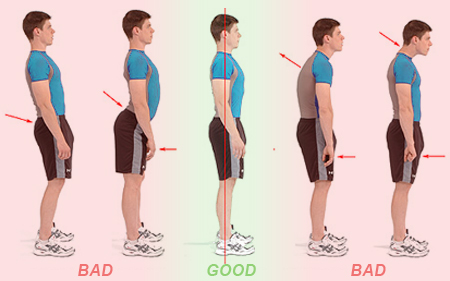
Maintaining proper posture is important to avoid worsening pain and stiffness. Good posture will help soft tissues heal correctly. Your physiotherapist can provide resources and advice to help maintain good posture such as a firm posture pillow while sleeping [13].
Rest VS. Exercise
In previous years, whiplash was treated by wearing a foam neck collar for weeks and bed rest when needed. The neck collar prevented the neck from moving and was intended to avoid any further damage to the neck [14]. However, this treatment option has been shown to slow the healing process and cause more damage than good. In order to heal from whiplash, the neck needs to strengthen and repair its soft tissues. This is best accomplished by careful exercise of the neck through physiotherapy.
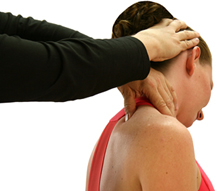
Once the acute symptoms of whiplash are gone, physiotherapy for whiplash will allow your neck muscles to become stronger and more limber. This will allow you make a quicker recovery and be more resistant to neck strain in the future [15]. Patients who became involved in motion exercises early after sustaining a whiplash injury are shown to have a more reliable and rapid recovery from their symptoms. This type of treatment usually involves certain rotation exercises repeated 10 times an hour as soon as symptoms allow the days following the accident [16].
The sooner the physiotherapy is started, the better. Early treatment is imperative to prevent lasting damage and chronic pain from whiplash. Current research supports that early neck exercises rather than immobilization with a foam collar brings a more prompt and full recovery both in the short and long term [17].
A common risk of whiplash is hyperlordosis; many patients over arch their neck and adopt bad posture to avoid pain [18]. This practise will not only prevent your whiplash from healing correctly, but can create chronic pain and long term neck problems. This is why it is important to treat whiplash under the supervision of a physiotherapist. Studies show that physical therapy within a few weeks or days after the whiplash injury can help to avoid hyperlordosis [19].
Physiotherapy will give you the resources to continue your whiplash treatment and exercise at home for 4-6 months following the accident. Your physiotherapy treatment for whiplash may include:
6. Whiplash Complications
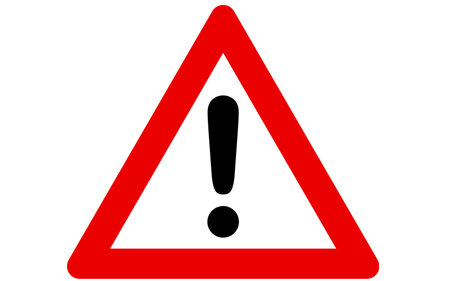
Whiplash injuries can cause a number of other, complex related problems such as:
Chronic Whiplash: Most patients with whiplash make a full recovery in a matter of weeks or months with proper treatment. But certain individuals with more serious damage can develop chronic whiplash with symptoms that remain for years. Women are frequently more seriously injured by whiplash because of the difference in muscular bulk and bone structures [20].
Concussion: The impact that causes whiplash can sometimes cause a concussion as well [21]. It is important to see a physician after your accident to assess the damage. If you are confused, nauseous, dizzy, or excessively sleepy after the accident seek medical attention immediately.
Joint Disfunction: One of the spinal or limb joints may lose its normal resilience or shock absorption as a result of the whiplash. This could lead to pain and restricted movement.
Disc Herniation: A whiplash injury may damage the discs between the vertebrae, causing a herniated disc. This condition may cause sharp, shooting pain down an arm as well as numbness, tingling and weakness [22].
Faulty Movement Patterns: As a result of a barrage of intense pain signals from the whiplash injury, the nervous system may change the way it controls muscle function, affecting one’s ability to coordinate movements [23].
Works Cited
How to Use Physical Therapy to Recover from Whiplash. Retrieved from http://www.wikihow.com/Use-Physical-Therapy-to-Recover-From-Whiplash
Murphy, D. (2000, August 17). What is Whiplash?. Retrieved from http://www.spine-health.com/conditions/neck-pain/what-whiplash
Murphy, D. (2000, August 17). How does Whiplash Occur?. Retrieved from http://www.spine-health.com/conditions/neck-pain/how-does-whiplash-occur
Neck Pain and Whiplash. (2014). Retrieved from http://www.csp.org.uk/your-health/conditions/neck-pain
Neck Whiplash. (2008). Retrieved from http://www.physioadvisor.com.au/9617350/neck-whiplash-whiplash-injury-physioadvisor.htm
Nordqvist, Christian. (2009, December 21). What is Whiplash? What Causes Whiplash?. Retrieved from http://www.medicalnewstoday.com/articles/174605.php
Ratini, Melinda. (2014, April 04). Neck Strain and Whiplash. Retrieved from http://www.webmd.com/back-pain/neck-strain-whiplash
Staff, Mayo Clinic. (2012, February 15). Whiplash. Retrieved from http://www.mayoclinic.org/diseases-conditions/whiplash/basics/definition/con-20033090
Whiplash. (2014, January 7). Retrieved from http://www.medicinenet.com/whiplash/article.htm
Whiplash (Medicine). (2014, May 9). Retrieved from http://en.wikipedia.org/wiki/Whiplash_%28medicine%29



